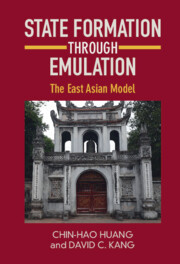Book contents
- State Formation through Emulation
- State Formation through Emulation
- Copyright page
- Epigraph
- Contents
- Preface
- 1 Introduction
- 2 Theories of State Formation and Diffusion
- 3 Phase I and Onwards
- 4 The Absence of Bellicist Pressures in State Formation, 400–800 CE
- 5 Phase II
- 6 Korea and Japan over the Centuries
- 7 Vietnam Emerges
- 8 Epistemic Communities and Regional Connections
- 9 Who Doesn’t Emulate?
- 10 Conclusion
- Appendix Major Events in Sinicization, 300–1100 CE
- Bibliography
- Index
6 - Korea and Japan over the Centuries
Published online by Cambridge University Press: 21 July 2022
- State Formation through Emulation
- State Formation through Emulation
- Copyright page
- Epigraph
- Contents
- Preface
- 1 Introduction
- 2 Theories of State Formation and Diffusion
- 3 Phase I and Onwards
- 4 The Absence of Bellicist Pressures in State Formation, 400–800 CE
- 5 Phase II
- 6 Korea and Japan over the Centuries
- 7 Vietnam Emerges
- 8 Epistemic Communities and Regional Connections
- 9 Who Doesn’t Emulate?
- 10 Conclusion
- Appendix Major Events in Sinicization, 300–1100 CE
- Bibliography
- Index
Summary
Korea and Japan continued to borrow from China throughout their histories. Japan is often mistakenly viewed as "feudal" and not a state; despite the fact that this "warring states" era in Japan was only 150 years of its total existence. The Japanese Tokugawa Shogunate (1600-1868) had far more centralized control over its land than did contemporaneous European states, for example. in Korea, the Choson dynasty intensified its borrowing of Confucinan ideas and Chinese culture.
Keywords
- Type
- Chapter
- Information
- State Formation through EmulationThe East Asian Model, pp. 119 - 133Publisher: Cambridge University PressPrint publication year: 2022

